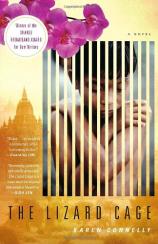Reading Group Guide
Discussion Questions
The Lizard Cage

1. During a meditation, Teza reflects on the following Buddhist principles:
Metta.
Karuna.
Mudita.
Upekkha.
These are the Four Divine Abidings. Love. Compassion. Joy in the good fortune of others. Equanimity.
How are these principles depicted in the novel, and in what way do they help Teza cope with his imprisonment? Does he always succeed in living by these principles? How does he impart them to Little Brother?
2. How do Teza’s experiences inside the Lizard Cage represent the larger political turmoil in Burma (now Myanmar)? Despite the inhuman conditions, does hope still reside inside the prison?
3. “Words are like the ants. They work their way through the thickest walls, eating through bricks and feeding off the very silence intended to stifle them.” How is the irrepressibility of truth evident in The Lizard Cage? What parallels can you draw from other civil rights conflicts in the world?
4. Brothers Teza and Aung Min chose different paths of resistance, the former peaceful protest and the latter armed revolution. In your opinion, whose choice was more effective? How does Teza keep their relationship alive through memory? In what ways is Teza’s friendship with Little Brother similar to his relationship with Aung Min?
5. Why are pen and paper contraband in the Lizard Cage? Even Little Brother, who cannot read and write, understands their power. How is language a powerful weapon against oppression?
6. “From solitary, the whole cage is a foreign country to him. He lives on the very edge of it, straining to hear the other voices.” While confined, Teza reflects on life, from his family and first love to his education and political actions. Can memories be both freedom from captivity and a torturous reminder of a life not lived? When have you experienced this paradox?
7. Little Brother is referred to by various names, most commonly the boy, rat killer, Free El Salvador, Nyi Lay, and his real name, Zaw Gyi. Why is Teza comforted to know the boy has such a strong name? What does one’s name signify in terms of social hierarchy and character?
8. Animals, particularly lizards, play an important role in The Lizard Cage. What is the significance of the characters’ relationships with animals? How are those relationships spiritual, and what do they teach us about human relationships?
9. How are jailers Handsome and Chit Naing products of the environment in which they live? Why do they have such different attitudes toward Teza even though they have the same occupation? Are they motivated by survival, loyalty, or ambition?
10. In what way does Teza achieve freedom through Little Brother? What does the novel say about the resilience of the human spirit?
The Lizard Cage
- Publication Date: April 8, 2008
- Paperback: 464 pages
- Publisher: Spiegel & Grau
- ISBN-10: 0385525036
- ISBN-13: 9780385525039







